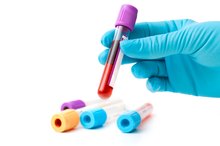Dizziness & Anemia
Anemia presents in a number of different forms with different symptoms. One symptom common to most types of anemia is dizziness. A patient with a diagnosis of anemia will note that dizziness began with the onset of the other anemia symptoms. Some forms of anemia make up a group of blood disorders that lack essential elements in the blood such as oxygen, iron and vitamins. Other types, like sickle cell anemia, result from the body manufacturing unusual-shaped blood cells that have trouble flowing through the blood vessels.
Definitions
Dizziness makes a person feel off balance or lightheaded. This lightheaded feeling can be brought on by anemia. Dizziness differs from vertigo, in that vertigo creates the sensation that the room spins around while the person remains still. This “spinning room” feeling has no relation to anemia. Instead, according to MedlinePlus, it has its roots in such conditions as labryrinthitis, Meniere’s disease and benign positional vertigo.
- Dizziness makes a person feel off balance or lightheaded.
- This lightheaded feeling can be brought on by anemia.
Significance
Are Night Sweats & Weight Loss Symptoms of Anemia?
Learn More
Anemia can strike an otherwise healthy person. Anyone who suffers an excessive loss of blood, like an accident victim or a postpartum woman, develops an acute case of anemia which often corrects itself or responds to therapy soon after the event. Chronic anemia sufferers experience ongoing fatigue, weakness and dizziness. These anemia types evolve from chronic illness, iron deficiency, other nutrient deficiencies, poor nutrient absorption, alcoholism, chemotherapy and other drug treatments, says "Current Medical Diagnosis and Treatment."
- Anemia can strike an otherwise healthy person.
- Anyone who suffers an excessive loss of blood, like an accident victim or a postpartum woman, develops an acute case of anemia which often corrects itself or responds to therapy soon after the event.
Cause of Dizziness
Hemoglobin, a component of the red blood cells, carries oxygen and delivers the oxygen to the body tissues. The Merck Manual Home Edition explains that when the level of hemoglobin drops or stays consistently low, the body gets deprived of oxygen, causing physical symptoms. Dizziness stems from the brain’s shortage of oxygen or can stem from low blood pressure resulting from poor oxygenation of the heart muscle and blood vessels.
Treatment
What Are the Causes of Decreased Saturation of Oxygen?
Learn More
Dizziness caused by anemia is treated indirectly. A physician will address the underlying cause of the anemia after evaluation and blood tests. If the anemia comes from an iron deficiency, iron therapy with oral iron tablets can correct it. This type of therapy also works for other blood deficiencies. Drugs that stimulate production of red blood cells can help chemotherapy patients. When the anemia is controlled, the dizziness and other symptoms of anemia improve.
- Dizziness caused by anemia is treated indirectly.
- This type of therapy also works for other blood deficiencies.
Warning
Dizziness caused by anemia should receive prompt medical care. Excessive dizziness can cause patients to suffer injuries from falls or other accidents. A medical workup is required to accurately diagnose the cause of dizziness and treat the underlying condition. Long-term effects of untreated anemia can be devastating, including heart attack, organ damage or even death, says the University of Illinois Medical Center.
- Dizziness caused by anemia should receive prompt medical care.
- A medical workup is required to accurately diagnose the cause of dizziness and treat the underlying condition.
Related Articles
References
- MedlinePlus: Dizziness
- Merck Manual Home Edition: Anemia
- "Current Medical Diagnosis and Treatment"; Stephen J. McPhee, M.D. and Maxine A. Papadadis, M.D., 2010
- University of Illinois Medical Center: Anemia
- Turner J, Badireddy M. Anemia. StatPearls Publishing. Updated January 16, 2019.
- Miller JL. Iron deficiency anemia: a common and curable disease. Cold Spring Harb Perspect Med. 2013;3(7):10.1101/cshperspect.a011866 a011866. doi:10.1101/cshperspect.a011866
- Ishii K, Young NS. Anemia of Central Origin. Semin Hematol. 2015;52(4):321–338. doi:10.1053/j.seminhematol.2015.07.002
- Packman CH. The Clinical Pictures of Autoimmune Hemolytic Anemia. Transfus Med Hemother. 2015;42(5):317–324. doi:10.1159/000440656
- Cascio MJ, Deloughery TG. Anemia: Evaluation and Diagnostic Tests. Med Clin North Am. 2017;101(2):263-284. doi:10.1016/j.mcna.2016.09.003
- Johnson-Wimbley TD, Graham DY. Diagnosis and management of iron deficiency anemia in the 21st century. Therap Adv Gastroenterol. 2011;4(3):177–184. doi:10.1177/1756283X11398736
- Sandoval C. Approach to the child with anemia. In: UpToDate, Post TW (Ed), UpToDate, Waltham, MA,
- Schrier SL. Approach to the adult patient with anemia. In: UpToDate, Post TW (Ed), UpToDate, Waltham, MA.
- Marks PW. Approach to Anemia in the Adult and Child. In: Hoffman R, Benz Jr. EJ, Silberstein LE, Heslop HE, Weitz JI and Anatasi J eds. Hematology: Basic Principles and Practice. 6th Ed. Philadelphia, PA: Elsevier Saunders; 2013.
Writer Bio
Vita Ruvolo-Wilkes was first published in 1977. She worked as a certified aerobics and exercise instructor. Upon graduating from the Wake Forest University School of Medicine, she worked for the VA Medical Center. As a physician assistant, Ruvolo-Wilkes designed specialized diets for her patients' conditions and has written a monthly health column in the "Montford Newsletter."








